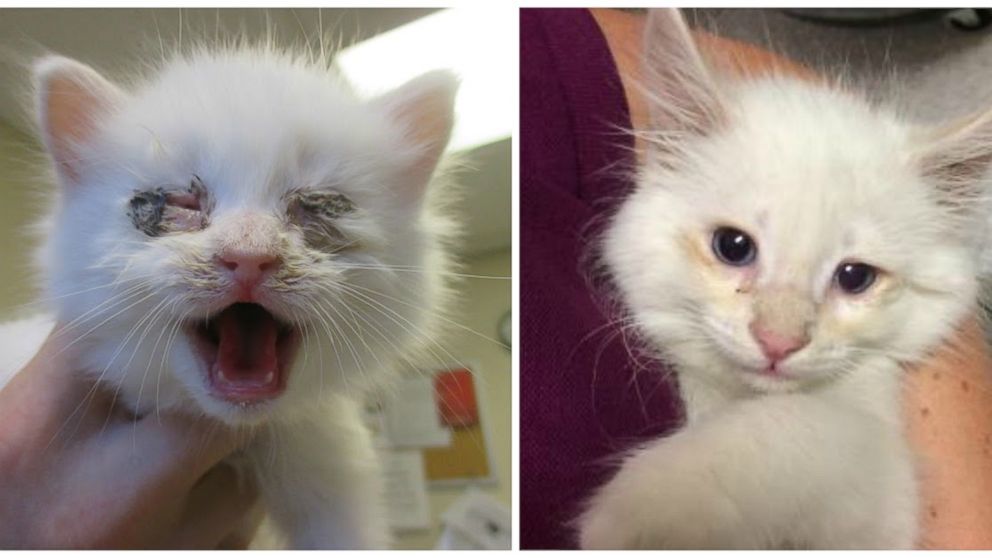Yes, cats can get eye infections. Eye infections in cats may be caused by viruses, bacteria, or allergies.
If you have a cat, it’s essential to keep an eye on their overall health, and that includes their eyes. Cat eye infections are not uncommon, and if left untreated, they can cause significant complications. These infections may occur due to a range of factors such as bacterial or viral infections. A cat’s eyes are susceptible to problems such as conjunctivitis, dry eyes, corneal ulcers, and glaucoma. As a cat owner, you must monitor your cat’s behavior, any discharge or unusual swelling around the eyes, and seek veterinary care if you notice any symptoms of an eye infection. In this guide, we will discuss the common symptoms of cat eye infections, causes, and treatments.

Credit: abcnews.go.com
What Are Eye Infections In Cats?
Cats can get eye infections caused by bacteria, viruses, fungi or parasites. Some common types of eye infections in cats include conjunctivitis, keratitis, and uveitis. Symptoms of eye infections include redness, discharge, squinting, cloudiness of the eye and swelling of the eyelids.
Causes of eye infections in cats may include injury, eye diseases, foreign objects in the eye or viral/bacterial infections. Any of these may lead to discomfort and vision problems in the cat. As an owner, it is important to watch out for any signs of eye infections in your cats and seek veterinary help immediately if you notice anything unusual.
Regular checkups for your pets can also help prevent and detect such infections early.
Diagnosing Eye Infections In Cats
Eye infections are a common concern for cat owners. When it comes to diagnosing these infections, it’s important to schedule an appointment with a veterinarian. During the visit, a veterinarian will examine your cat’s eye(s) and ask about any symptoms your cat may be experiencing.
If necessary, additional tests may be performed to confirm the diagnosis. These tests may include a fluorescein stain to check for lesions or ulcers, cultures to identify the bacteria causing the infection or bloodwork to check for underlying health issues.
By working with a veterinarian, you can ensure that your cat receives proper treatment to alleviate any discomfort and promote healing.
Cat's Eyes swollen and watery: Cat Conjunctivitis Treatment
Treatment Options For Eye Infections In Cats
Cats can absolutely suffer from eye infections as a result of bacterial, viral or fungal infections, allergies, trauma, or foreign objects getting into the eyes. Depending on the severity of the cat’s condition, treatment options can vary. Most commonly, the vet will prescribe ophthalmic medications like eye drops or ointments to be applied directly to the affected eye.
These may include antibiotics, antivirals, or antifungals. In addition to medications, you can use home remedies to ease your feline companion’s symptoms. These can include chamomile tea or a sterile saline solution for rinsing out the eye, or a warm compress to help reduce inflammation.
If you suspect your cat has an eye infection, it’s important to take them to the vet as soon as possible for proper diagnosis and treatment.
Prevention Strategies For Eye Infections In Cats
Prevention strategies for eye infections in cats cats are prone to developing eye infections, just like humans. However, there are several steps you can take to reduce the risk of your cat contracting eye infections. The first is to maintain good hygiene practices, such as keeping your cat’s litter box clean and washing your cat’s paws regularly.
Additionally, you should take care to regularly clean your cat’s eyes and surrounding areas with a damp cloth. Another important strategy is to make sure your cat has a healthy diet, as poor nutrition can weaken the immune system. You should also ensure that your cat is vaccinated against infectious diseases that can lead to eye infections.
By following these prevention strategies, you can help keep your cat’s eyes healthy and infection-free.
What Is Feline Herpesvirus?
Feline herpesvirus is a common virus that can infect cats. It spreads through direct contact or airborne particles. The virus attacks the respiratory system, causing symptoms such as sneezing, coughing, and eye infections. Feline herpesvirus can be mistaken for other diseases, so it’s important to get a proper diagnosis from a vet.
Unfortunately, there is no cure for the virus, but supportive care can help manage symptoms. Regular vet checkups and vaccinations can help prevent infection and reduce the severity of symptoms. As a cat owner, it’s important to understand the virus and take appropriate measures to protect your cat’s health.
Symptoms And Diagnosis Of Feline Herpesvirus
Feline herpesvirus, also known as feline viral rhinotracheitis, is a highly contagious virus that causes respiratory infections in cats. Symptoms of the virus can include sneezing, nasal discharge, fever, and ocular discharge. The latter symptom can mimic an eye infection.
The virus typically spreads through contact with infected cats or through contaminated objects, such as food bowls and litter boxes. A veterinarian can diagnose feline herpesvirus through a combination of clinical signs and laboratory testing, such as a viral swab or blood test.
Treatment can include antiviral medications, supportive care, and management of any secondary symptoms, such as conjunctivitis or dehydration. It is important to provide infected cats with proper care and support to help manage the virus and limit its spread to other cats.
Treatment Options For Feline Herpesvirus
Feline herpesvirus is a common illness among cats that can lead to eye infections. The good news is that there are various treatment options available to ease the symptoms. Some medications such as antivirals and antibiotics can be used to treat infections, along with therapies like lysine supplements and herbal remedies.
Furthermore, taking preventive measures can help reduce the risk of virus recurrence. Keeping your cat stress-free, regular veterinarian checkups, and proper hygiene are just some of the preventive measures. Overall, treating feline herpesvirus is a manageable condition, especially with early diagnosis and the right treatment plan.
What Is Feline Chlamydia?
Feline chlamydia is a bacterium that affects cats, similar to the human strain. It can cause inflammation of the eyes called conjunctivitis. While outdoor cats are more likely to become infected, cats in multi-cat households are also at risk. Feline chlamydia is highly contagious and spreads through contact with an infected cat’s stool or oral and nasal secretions.
Kittens can also contract the infection from their mothers. In severe cases, it can lead to pneumonia or nasal infections. Early detection and treatment with antibiotics are crucial for a full recovery. Regular check-ups with your vet and keeping your cat’s environment clean can help prevent feline chlamydia infections.
Symptoms And Diagnosis Of Feline Chlamydia
Feline chlamydia is a common infection that affects cats’ eyes. If your cat shows signs of eye discharge, redness, or itchiness, they may have feline chlamydia. Other symptoms include sneezing, loss of appetite and fever. To diagnose this infection, your veterinarian may perform a physical examination, a swab test or a blood test.
The treatment will depend on the severity of the infection, but antibiotics are usually prescribed. Do not let this infection go untreated as it can lead to blindness or other serious complications. Keep your cat’s living space clean and wash your hands regularly to prevent the spread of feline chlamydia.
Treatment Options For Feline Chlamydia
Cats are prone to eye infections, including feline chlamydia. The most effective treatment is prescription antibiotics and eye drops. Usually, the course of treatment lasts for two to six weeks. If the chlamydia has caused other infections, additional medications may be required.
Follow-up appointments with a veterinarian are necessary to track the cat’s progress. To reduce the risk of infection recurrence, keep the cat’s environment clean and avoid letting them come into contact with other infected cats. Providing a healthy diet, clean water, and regular grooming may also help boost their immune system and prevent future infections.
Quick attention to eye infections is key to getting your cat back to their happy and healthy self.
Frequently Asked Questions For Do Cats Get Eye Infections
Conclusion
After reading this blog post, you now know that eye infections can happen to cats and the symptoms to look out for. It’s important to take care of your cat’s eyes and address any issues as soon as possible to avoid additional health complications.
Preventing infections is possible with regular checkups, cleaning, and keeping your cat’s environment clean. If you suspect your cat has an eye infection, don’t hesitate to take them to the vet for a proper diagnosis and treatment. Remember to provide them with a healthy diet and maintain their overall health to keep their immune system strong.
With proper care and attention, you can help ensure your furry friend stays healthy and happy for many years to come.
{ “@context”: “https://schema.org”, “@type”: “FAQPage”, “mainEntity”: [] }


